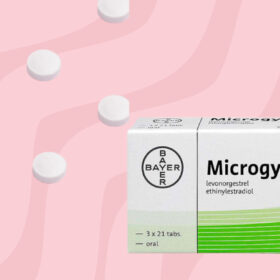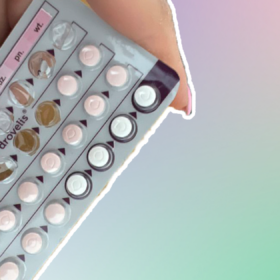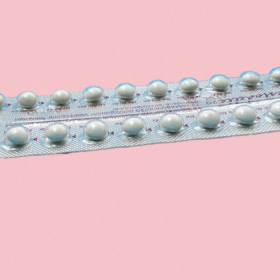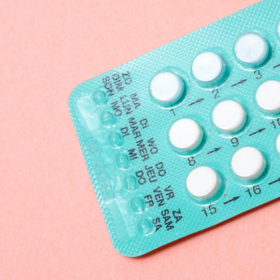
The Combined Pill – Everything you need to know
The combined pill is often the first method of contraception many of us use. It is an extremely popular method of contraception due to its accessibility and simplicity, as well as the many different brands available offering lots of choice. Many women also turn to the pill not only as a contraceptive but for help with other problems. This magic pill might be small, but certainly packs a punch when it comes to controlling acne, periods and hormones – so definitely isn’t just a one-trick pony!
What is the combined pill?
The combined pill, also known as ‘The pill’, is an oral contraceptive that is taken daily. It contains artificial versions of the female hormones oestrogen and progesterone. There are many different brands of pill (including Rigevidon, Microgynon and Yasmin birth control pill), which can be classified in different ways:
Monophasic pills:
Each pill has the same amount of hormones in it. Traditionally, one pill is taken each day for 21 days and then no pills are taken for the next 7 days. During this break you experience a withdrawal bleed (like a period). For most brands you can choose to shorten this break or miss it out altogether (and avoid a withdrawal bleed). This is called taking the pill back-to-back and is completely safe.
Multiphasic pills:
One pill is taken each day for 21 days, but each pill provides different levels of hormones. No pills are taken for the next 7 days during in which you will have a withdrawal bleed. Phasic pills need to be taken in the correct order.
Every day (ED) pills:
There are 21 active pills (containing hormones) and seven inactive pills (also known as dummy, placebo or sugar pills, containing no hormones) in a pack – they are different colours in the packet. One pill is taken each day for 28 days with no break between pill packets. ED pills need to be taken in the right order.
How does the combined pill work?
The pill prevents pregnancy in three ways – by stopping ovulation, by making the fluid in your cervix thicker (which makes it more difficult for sperm to enter the womb), and by preventing the lining of your womb thickening enough for a fertilised egg to implant into it.
How effective is the pill?
If the pill is taken perfectly (meaning you don’t miss any), it is over 99% effective. However, the effectivness is 91-93% for typical use of the combined pill.
What are side effects of the pill?
Minor side effects of the pill can include mood swings, nausea, tenderness in breasts and headaches. Despite what people may say, 48% of The Lowdown users report no change in weight and 31% state they had gained weight after being on the combined pill. (Data taken from November 2024)
After much debate, there is no proof that the combined pill CAUSES weight gain. Research does admit that women can put on weight while using the combined pill, but this is thought to be due to natural weight gain as part of ageing that would happen normally without contraception.
What are the risks of the pill?
There are some risks with the combined pill that you should know about. These risks are very small but important. These include an increased risk of blood clots, cardiovascular disease (conditions that affect your vessels and heart like strokes or heart attacks) and breast or cervical cancer. The pill does not protect against STIs, but luckily the trusty condom can be used alongside this contraceptive to avoid any sexually transmitted illnesses.
How do I use the combined pill?
You can get the the combined pill from your GP, local sexual health service and community or online pharmacies. Before you are prescribed the pill, your healthcare professional will do some tests to ensure it is safe for you. They will check your medical history, make sure you’re not pregnant, check your height and weight and take your blood pressure.
Most women can start the pill at any time in their menstrual cycle. If you start your pill within 5 days of starting your period you will be protected from pregnancy straight away (if you have a short cycle then speak to your doctor or nurse). At any other time in your cycle you will need to use condoms or avoid sex for 7 days before you are protected from pregnancy. Make sure you read the packet carefully and speak to a health professional if switching from another hormonal contraception method. There are special instructions for starting the pill if you’ve just had a baby, abortion or miscarriage.
You will normally be given a prescription for 3 to 12 months initially and will need to go back to your doctor for a check-up once a year. At your annual check up, you should have your height, weight, blood pressure and medical history reviewed, alongside discussing any side effects or complications from the pill.
It’s important to take the pill around the same day every day – for example, first thing in the morning, or before you go to bed at night. It can often be helpful to associate it with something else in your routine, i.e when you have breakfast, or after you’ve brushed your teeth. You could also keep it somewhere that you look everyday, i.e makeup bag. But if you do have the memory of a fish, you could just set an alarm on your phone to ensure there’s absolutely no way you could forget to take your pill!
Most types of combined pill were designed to be taken for 21 days followed by a 7 day break during which you’ll experience a withdrawal bleed (like a period). For most brands you can choose to shorten this break or miss it out altogether which is called continuous pill taking.
What happens if you miss a pill?
If you miss a pill or pills, or you start a pack late, this can make the pill less effective. The chance of getting pregnant after missing a pill or pills depends on when the pills are missed and how many pills are missed. Our missed pill calculator can help you work out what to do next.
If you vomit within two hours of taking the pill, it may not have been fully absorbed into your bloodstream. Take another pill straight away and then the next pill at your usual time. If you continue to be sick, keep using another form of contraceptive until you’ve taken the pill again for seven days without vomiting.
Very severe diarrhoea (six to eight watery stools in 24 hours) may also mean that the pill won’t work properly. Keep taking your pill as normal, but use additional contraception, such as condoms, while you have diarrhoea, and for two days after recovering.
How do I stop using the pill?
Stopping the pill is super easy – you literally just stop taking it. However, be aware that as soon as you stop, you are no longer protected from pregnancy. If you’ve taken 21 consecutive pills, you may ovulate from any time from 7 days after you’ve finished the packet so consider if you need to switch to another method for ongoing contraception.
Combined pill VS mini pill
The main difference between these two pills are the hormones present in them. The combined pill contains two hormones, oestrogen and progestogen, while the mini pill only contains progestogen.
Pros and cons of the combined pill
Pros
- You are able to control when you have withdrawal bleeds or taken the pill continuously and avoid them altogether
- It doesn’t interrupt sex
- The combined pill can reduce your risk of cancer of the ovaries, womb (endometrial cancer) and colon
- It can reduce symptoms of PMS and PMDD
- It can help improve acne
- It can help treat heavy or painful periods
- It can help manage symptoms of PCOS, endometriosis and adenomyosis
Cons
- Some medicines and antibiotics can change the way your body digests the pill (check with a doctor or nurse if you are unsure)
- You need to remember to take it every day and may forget to take it
- Vomiting or diarrhoea can make the pill ineffective
- With any combined type of hormonal contraception, there is a slightly increased risk of developing blood clots
- There is a small increased risk of breast cancer while using the combined pill but this reduces with time after stopping it
- If you use the combined pill for more than 5 years, there is a small increased risk of cervical cancer, but this reduces over time after stopping the pill
- It doesn’t protect against STIs
- Side effects include mood and libido changes, breast tenderness and swelling, headaches, bloating, nausea and vomiting and breakthrough bleeding, although these are usually temporary.
Who shouldn’t use it?
Your doctor or nurse will need to ask about your own and your family’s medical history. The combined pill might not be suitable if:
- you smoke and are 35 years old or over
- you have a BMI over 35
- you take certain medicines
- you’re breastfeeding a baby less than 6 weeks old
The combined pill is not be suitable for you if you have ever had a blood clot known as a deep vein thrombosis in the legs or the legs, or risks factors for this, heart disease, stroke or high blood pressure. Other reasons you may not be able to take the combined pill include: migraines with aura, breast cancer or a genetic risk of breast cancer, liver disease and diabetes with complications.
At the age of 50 if you are taking the combined pill you will be advised to switch to another form of contraception. This is because at this age the risks of the combined pill are thought to outweigh the benefits.
Where can I get the pill?
Contraception is free to everyone on the NHS. The pill is available in contraception clinics, sexual health clinics, GP’s surgeries, commnuity pharmacies and some young people’s services. You can also access the pill for free through our online pharmacy service.
Our medical review process
This article has been medically reviewed for factual and up to date information by a Lowdown doctor.






